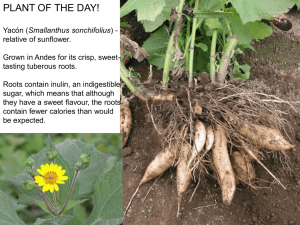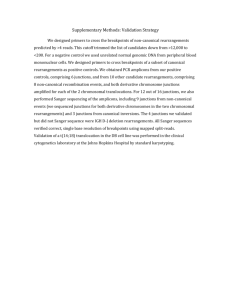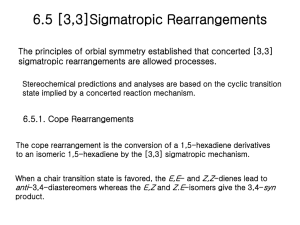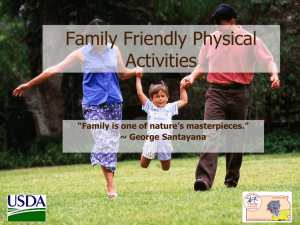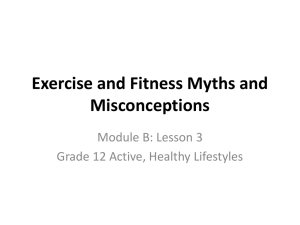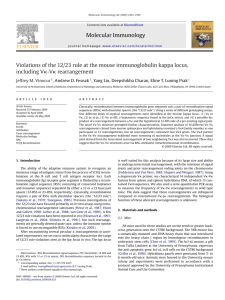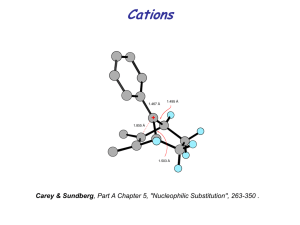H. petiolaris
advertisement
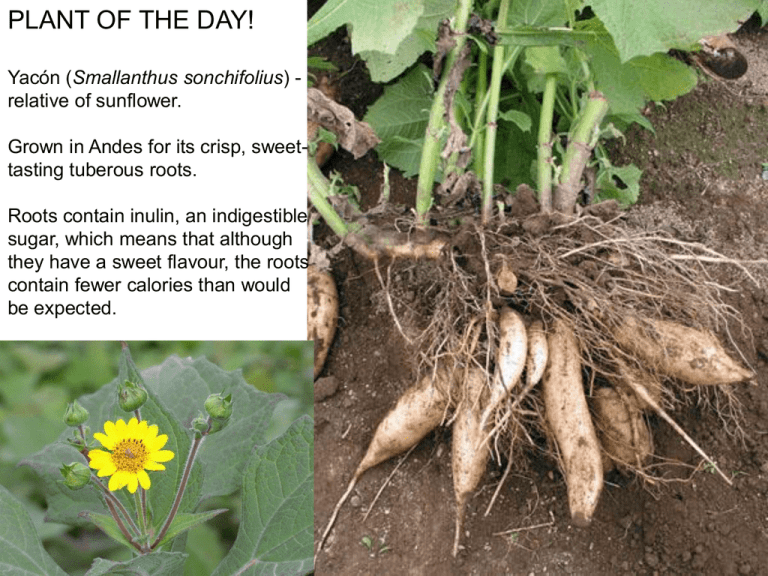
PLANT OF THE DAY! Yacón (Smallanthus sonchifolius) relative of sunflower. Grown in Andes for its crisp, sweettasting tuberous roots. Roots contain inulin, an indigestible sugar, which means that although they have a sweet flavour, the roots contain fewer calories than would be expected. Karyotypic changes and speciation Chromosomal speciation Chromosomal Speciation • Caused by chromosomal rearrangements • Fixed differences between species – > 95% of plant and animal species differ in their karyotype White (1978) • How does this cause reproductive isolation? – Reduced fertility in hybrids – Reduction in recombination Karyotype - the number and appearance of a set of chromosomes H. petiolaris H. annuus Historical distribution of two Helianthus species H. petiolaris H. annuus Meiotic abnormalities in F1 hybrids between Helianthus annuus and H. petiolaris Clarkia biloba Clarkia lingulata • Differ by a reciprocal translocation and two paracentric inversions • C. lingulata 2n=9 whereas C. biloba 2n=8 • Hybrids are readily made, but have near-complete sterility Types of Rearrangements 1. Inversions - paracentric (centromere outside inversion) - pericentric (centromere inside inversion Meiosis in a Pericentric Inversion Heterozygote A B C D A C B D Pairing Crossover B C C B A A D D Segregation End of Meiosis I A B C D A B C A D B C D D B C A End of Meiosis I I A B C A B C D B C D B C D Normal Product Duplication A arm A Deletion D arm D Duplication D arm Deletion A arm Inversion Product A Types of Rearrangements 1. Inversions (continued) Fertility effects - up to 50% of gametes carry duplications or deficiencies - may be compensatory mechanisms (a) in Drosophila recombinant products shunted into polar bodies (b) In deer mice abundant pericentromeric heterochromatin reduces crossing over Recombination effects - recombination suppressed within inverted region Types of Rearrangements 2. Chromosome fusions / fissions A + B Fertility effects - none to mild Recombination effects - none expected A B Types of Rearrangements 3. Translocations - reciprocal - nonreciprocal Types of Rearrangements 3. Translocations con’t Fertility effects - up to 2/3 of gametes will carry duplications or deficiencies - fertility effects slightly mitigated in some plant species by non-random meiotic configurations Recombination effects - recombination suppressed near centromere - considerable recombination in distal regions of chromosomes How can karyotype diverge? Strong underdominance -Establishment difficult -Strong reproductive barrier Fitness How can karyotype diverge? y x Weak underdominance -Establishment easier -Weak reproductive barrier How can karyotype diverge? paradox: strong underdominance - establishment unlikely weak underdominance - weak reproductive barrier 1. Drift (small population size, founder effects, kin founding) - Unlikely: fastest rates of chromosomal evolution recorded in taxa with very large populations (Strasburg and Rieseberg 2008) 2. Selection/migration balance (selection for multiple locally adapted alleles will favor establishment of rearrangements that limit recombination among them) How can karyotype diverge? 2. Selection/migration balance (selection for multiple locally adapted alleles will favor establishment of rearrangements that limit recombination among them) Fitness abc CBA CBA abc y x How can karyotype diverge? 3. Rearrangements weakly underdominant individually but strongly underdominant in combination (chromosomal fusions) B A A B C Ancestral population Pop. 1 C Pop. 2 B A C Derived populations How can karyotype diverge? 4. In highly redundant genomes, rearrangements have little effect on fitness; fitness effects become more severe with loss of functional redundancy over time A B C D Normal Product Duplication A; Deletion D A B C A A B C D Why are underdominant rearrangements more common in plants than animals? • Plants can self, at least at some low frequency (Rieseberg 2001; Coyne & Orr 2004) • Plants have greater genetic redundancy due to polyploidy and segmental duplication. This reduces the initial underdominance of chromosomal rearrangements, facilitating their establishment. Chromosomal Rearrangements as Recombination Modifiers Reduced recombination may: 1) Increase size of region protected from gene flow 2) Facilitate accumulation of BDM incompatibilities (or other species differences) in the presence of gene flow 3) Promote sympatric or parapatric speciation by creating associations between alleles under divergent natural selection and those that cause assortative mating Chromosomal Rearrangements versus BDM incompatibilities Chromosomal rearrangements reduce fitness in heterozygotes Prediction: F1 fitness < F2 fitness BDM incompatibilities often are recessive Prediction: F1 fitness > F2 fitness
